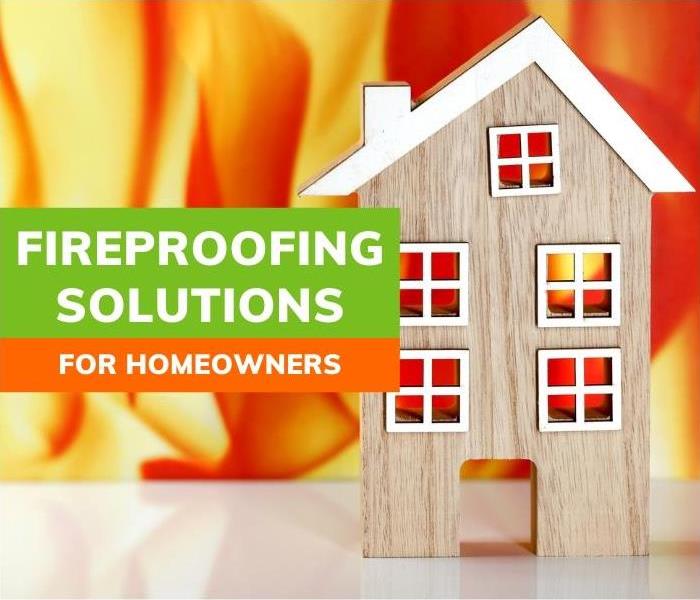Top Fireproofing Solutions for Homeowners
3/28/2025 (Permalink)
Top Fireproofing Solutions for Homeowners
Fire safety measures are critical for homeowners, especially those in fire-prone areas. Proactively fireproofing a home helps maintain its value while protecting its precious occupants.
Whether upgrading insulation or reworking the garden with fire-resistant plants, investing in these solutions can provide the vital seconds or minutes that make all the difference in an emergency.
Add Fire-Rated Insulation
Remove the home's existing insulation and install a safer, fire-rated product. This adds significant protection by hindering the spread of flames. Insulation materials like non-combustible mineral wool or ceramic fiber increase a home's resistance to high temperatures.
While the insulation slows the spread of fire, it also provides more time to safely remove loved ones from the structure and respond effectively to the threat. Fire-rated insulation complies with local safety regulations and may be required in critical spaces such as stairwells. As a bonus, fire-rated insulation also improves the home’s energy efficiency.
Integrate Fire-Resistant Materials
Various materials, such as fire-retardant coatings and fire-resistant building materials, offer enhanced protection. Some of the best fire protection comes from concrete, stucco, gypsum, and brick exteriors. Top home fireproofing solutions include using coatings made explicitly for wood surfaces, such as fire-retardant paint or primer coatings.
Add a clear fire-retardant coating to any surface to enhance a home's structure and aesthetics. This treatment extends the time for materials to ignite when exposed to flames. Retardants also reduce the ability of fire to spread to nearby structures. The coatings can be reapplied during periodic maintenance for continued protection.
Use Protective Building Materials
Renovating an existing home using fire-safe materials gives an extra layer of protection. Choose non-combustibles such as fiber cement siding, concrete, or certain types of stone, such as sandstone. Consider green solutions such as Timbercrete, made of recycled timber cellulose, which has natural fire-resistant properties and reduces the building’s carbon footprint. Metal and reinforced concrete building elements can add aesthetic beauty and additional protection.
Ensure the renovations adhere to local building codes and standards and choose tested certified products. Pay attention to whether materials are fire-resistant or fire-retardant. Fire-resistant materials are inherently resistant to catching fire, so they self-extinguish flames and do not drip or melt if exposed to heat. Fire-retardant materials have been treated with chemicals to make them self-extinguish, but the coating may need reapplication over time.
Invest in Fire-Resistant Windows and Doors
Fire-resistant windows and fire-rated doors help safeguard interior spaces as critical barriers to slow fire spread into and within a structure. Choose engineered glass windows that can withstand high temperatures and thermal shock without breaking. During a fire, the rapid temperature change can cause standard windows to break, allowing heat and flames to penetrate the home.
These windows typically have double panes that distribute heat more evenly and better protect against flames. The double panes also act as insulation for the home, increasing comfort and overall energy efficiency.
Fire-rated doors significantly slow the spread of fire into or within a home. They can withstand high temperatures and often come with seals to prevent smoke infiltration. Interior fire-rated doors can close off different areas, making it easier to contain flames, heat, and smoke. They also aid in safer exits during emergencies, making them one of the top fireproofing solutions for homeowners. After a fire, the home may require professional smoke damage services, and closing off sections with fire-rated doors can keep the damage and restoration work to a minimum.
Install Automatic Fire Sprinklers
Automatic home fire sprinkler systems provide a critical safety function by suppressing flames as soon as a fire starts. According to FEMA, fire sprinklers and smoke alarms reduce the risk of individuals dying in fires by 82%. Home fire sprinklers activate by sensing temperature changes, spraying only in the area of a fire. They reduce the flame, smoke, and heat, which makes it safer for home occupants and firefighters.
The systems can be installed during a renovation and are flush with the ceilings. Sprinklers minimize fire-related property damage and cause less destruction than water damage from firefighting hose lines.
Incorporate Advanced Systems for Fire Detection
Detecting a fire early can make all the difference between a minor event and catastrophic damage. Smoke alarms usually last about 10 years, so when it’s time for replacements, add heat and standard smoke detectors. Consider systems that have smart features, such as a mobile phone app that sends immediate notifications.
Ensure the sensors or detectors are inspected about once per month and tested periodically for proper maintenance. Place the detectors in strategic positions throughout the house and link them so that all the detectors sound if one sounds. Consider that once a smoke alarm sounds, home occupants may have less than two minutes to evacuate to a safe space.
Make Outdoor Spaces Defensible
Wildfires move quickly; something as small as a flying ember can endanger homes. Creating defensible space around the outside of a home reduces the risk of catching fire, which is another of the critical top fireproofing solutions for homeowners. Remove flammable debris and vegetation from yard areas around the structure. Create a buffer zone around the home using non-combustible materials such as gravel, concrete paths, patios, and stone retaining walls.
Avoid using combustible mulch in or around plant beds. Instead, substitute it with non-combustibles such as pea gravel or decomposed granite. Enhance the garden with fire-resistant plants, like succulents, agave, ice plants, and aloe. These plants retain moisture, resist burning, and act as a barrier to stop fire from spreading. Add fire-resistant shrubs and trees, keeping them trimmed and at least 10 feet from the home and potential sparks from a chimney.
Strategic Upgrades Provide Peace of Mind
Implementing solutions to make a home fire-proof is an essential investment for any homeowner. From installing fire-retardant building materials to adding home fire sprinklers, these upgrades can enhance safety and reduce the risk of fire damage.
As part of your home maintenance or fire restoration plan, add services like residential air duct cleaning to remove smoke, dust, and odors and to improve interior air quality. SERVPRO®'s qualified professionals can help you proactively keep your home safe and secure against fire. Contact us today for more information.






 24/7 Emergency Service
24/7 Emergency Service
